Why Hybrid Programs Reduce the Risk of Missed Preventive Screenings
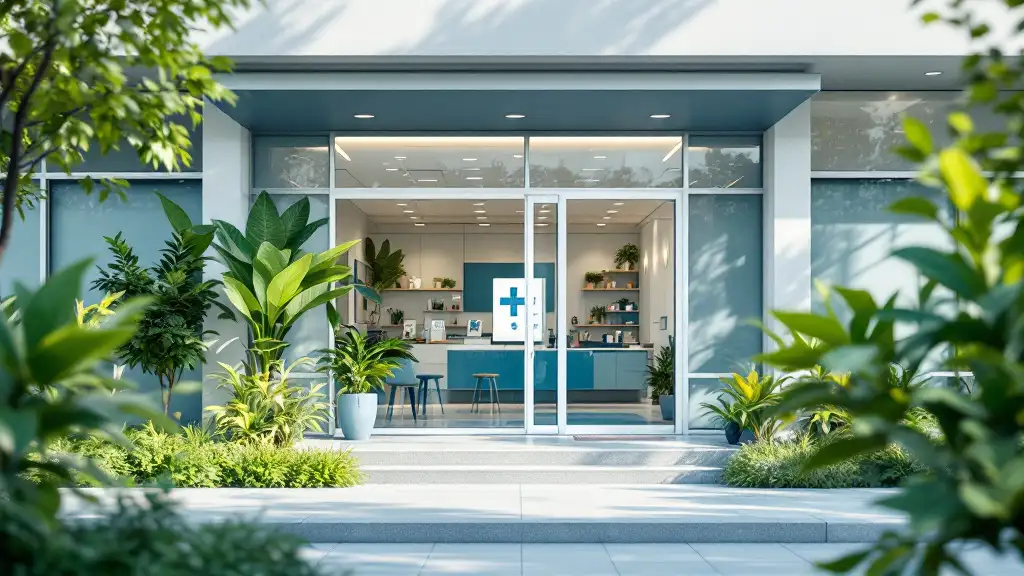
Bridging the Gap Between Traditional and Digital Healthcare to Minimize Missed Screenings
The evolving landscape of healthcare has seen an increasing integration of hybrid programs that combine in-person and digital approaches. These models are proving essential in reducing missed preventive screenings, especially amid challenges like the COVID-19 pandemic. By leveraging systematic interventions and innovative technologies, hybrid programs offer a comprehensive pathway to improve preventive care delivery, ensuring early detection and better health outcomes.
The Role of Systematic Interventions in Enhancing Screening Rates
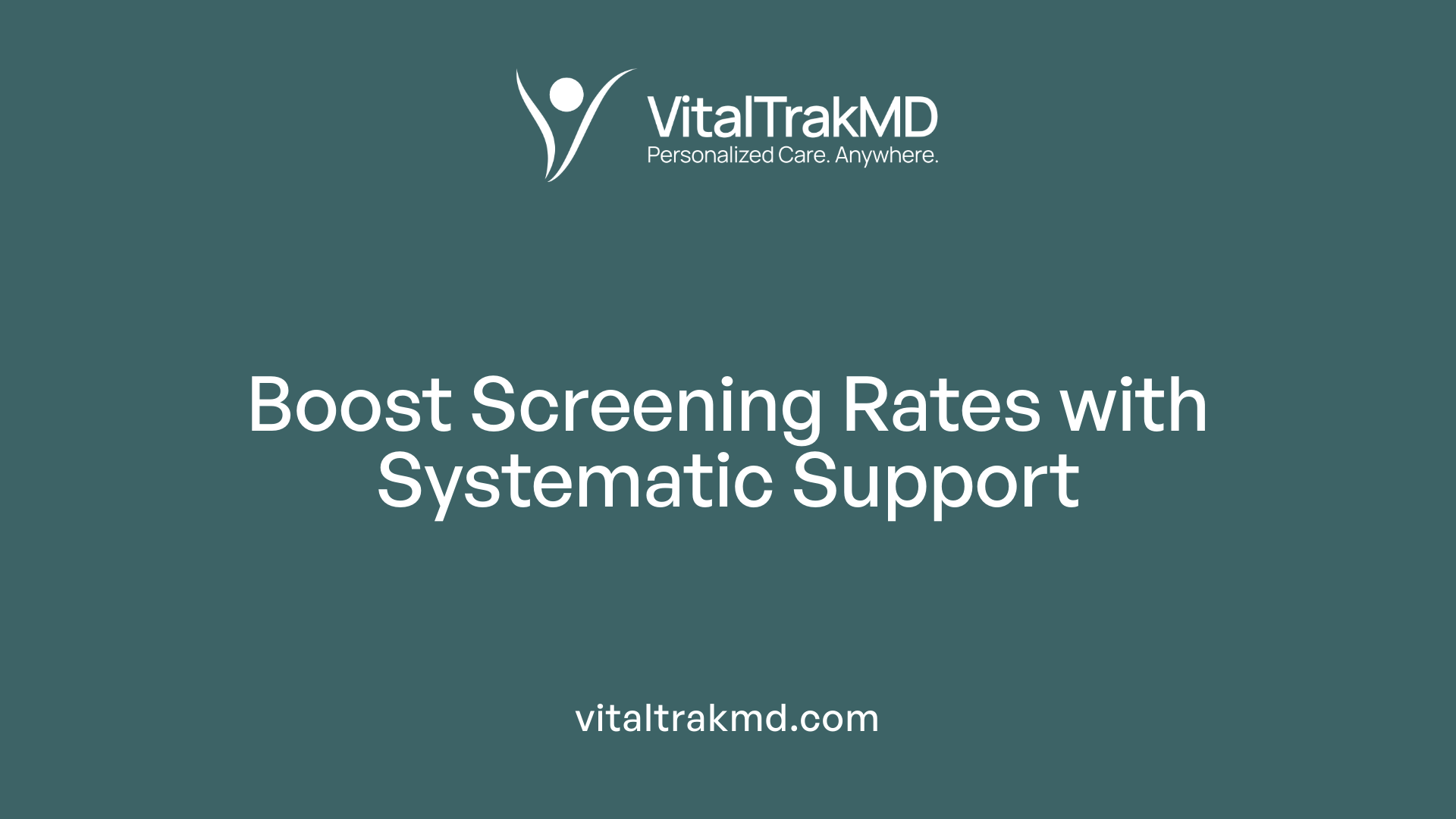
How do Best Practice Advisories (BPAs) and nurse navigators improve lung cancer screening?
Implementing systematic tools like Best Practice Advisories (BPAs) and deploying nurse navigators can significantly boost screening rates in lung cancer prevention programs. BPAs act as real-time prompts within electronic health records, reminding healthcare providers to screen eligible patients according to established guidelines. This reduces missed opportunities and ensures consistency in screening practices.
Nurse navigators, on the other hand, provide personalized patient support by coordinating appointments, addressing concerns, and educating patients about the importance of screening. This support increases patient engagement and adherence, leading to higher screening completion rates.
When combined, these interventions streamline the screening process, making it more efficient and targeted. They also help in identifying and reducing the screening of ineligible patients, thereby optimizing resource use.
How do these systematic interventions improve program quality?
Adding structured interventions like BPAs and nurse navigation enhances the overall quality of screening programs. They facilitate adherence to screening guidelines, which minimizes unnecessary tests on ineligible patients, thus reducing false positives and associated harms.
Furthermore, these tools help improve the risk profile of the screened population by encouraging high-risk individuals to participate. As a result, the detection of potential lung cancers occurs more frequently among those at genuine risk, increasing the program's effectiveness.
Improved adherence to guidelines also ensures that screenings are performed at appropriate intervals and with proper procedures, leading to more reliable outcomes.
How does provider behavior influence screening approaches?
Primary care providers (PCPs) play a crucial role in lung cancer screening adoption. However, provider behaviors vary due to differences in practice styles, awareness, and workflow constraints.
Systematic tools like BPAs can influence and encourage clinicians to follow recommended screening protocols consistently. By providing timely alerts and evidence-based recommendations, BPAs nudge providers toward initiating appropriate screenings.
This influence helps bridge the gap between guideline knowledge and clinical practice, increasing screening activity and ensuring high-risk patients are not overlooked.
What is the relevance of hybrid programs like VA-DPP and their impact?
Hybrid programs such as the VA- Diabetes Prevention Program (VA-DPP) demonstrate that integrating multiple approaches can lead to substantial health improvements. VA-DPP delivers lifestyle interventions through community health workers (CHWs) using low-intensity, manageable programs.
Participants in VA-DPP experienced impressive reductions in systolic and diastolic blood pressure, along with increased adherence to clinical thresholds. Dietary and physical activity behaviors also improved, and retention rates were high at 87%, indicating the feasibility in rural and underserved settings.
This success underscores the potential of hybrid models that combine community-based behavioral support with clinical screening efforts. Such programs can effectively reach high-risk populations, reduce missed preventive screenings, and foster sustainable health behavior changes.
How can technological advances augment screening efforts?
Artificial Intelligence (AI) and predictive analytics are emerging as powerful tools in preventive care. AI-driven systems can enhance detection accuracy, such as earlier diagnosis of lung cancers, and support clinicians through lesion detection and severity assessment.
Predictive models can identify individuals at heightened risk for diseases like diabetes, asthma, or COPD, enabling proactive screening and earlier interventions. Prescriptive analytics consider cultural, behavioral, and environmental factors to tailor patient-specific recommendations, improving engagement and adherence.
Wireless sensor systems further support medication adherence, indirectly boosting preventive efforts. For example, sensors tracking inhaler or insulin use can flag deviations and prompt timely interventions.
Together, these technological innovations help reduce missed screenings and optimize preventive strategies.
What are common barriers and facilitators in implementing hybrid screening programs?
Despite potential benefits, several barriers hinder effective implementation. These include low referral rates for high-risk individuals, clinicians' limited time, and logistical challenges like staffing and space constraints.
Facilitators that promote success involve strong leadership backing, comprehensive staff training, and supportive healthcare policies. Engaging clinicians and staff at all levels ensures alignment with program goals.
Cost considerations also matter. For example, the VA-DPP's approximate costs per individual for eligibility assessment ($68), adherence ($328), and session delivery ($101) are manageable within health system budgets.
Adopting multicomponent strategies—such as clinical reminders, clinician education, and information sharing—significantly increase processes of care, with odds ratios ranging from 1.89 to over 3.4.
How can these systematic efforts be integrated for maximum impact?
Combining clinical decision support tools, community outreach, technological innovations, and policy support creates a comprehensive approach to prevent missed screenings. It improves accuracy, increases patient engagement, and ensures that high-risk populations are effectively reached.
In the end, such integrated, hybrid models support early detection, appropriate treatment, and better overall health outcomes, especially among underserved and vulnerable groups. This coherent approach leads to more equitable, efficient, and effective preventive health strategies across various settings.
Influence of Provider Behavior and Digital Tools on Screening Adoption
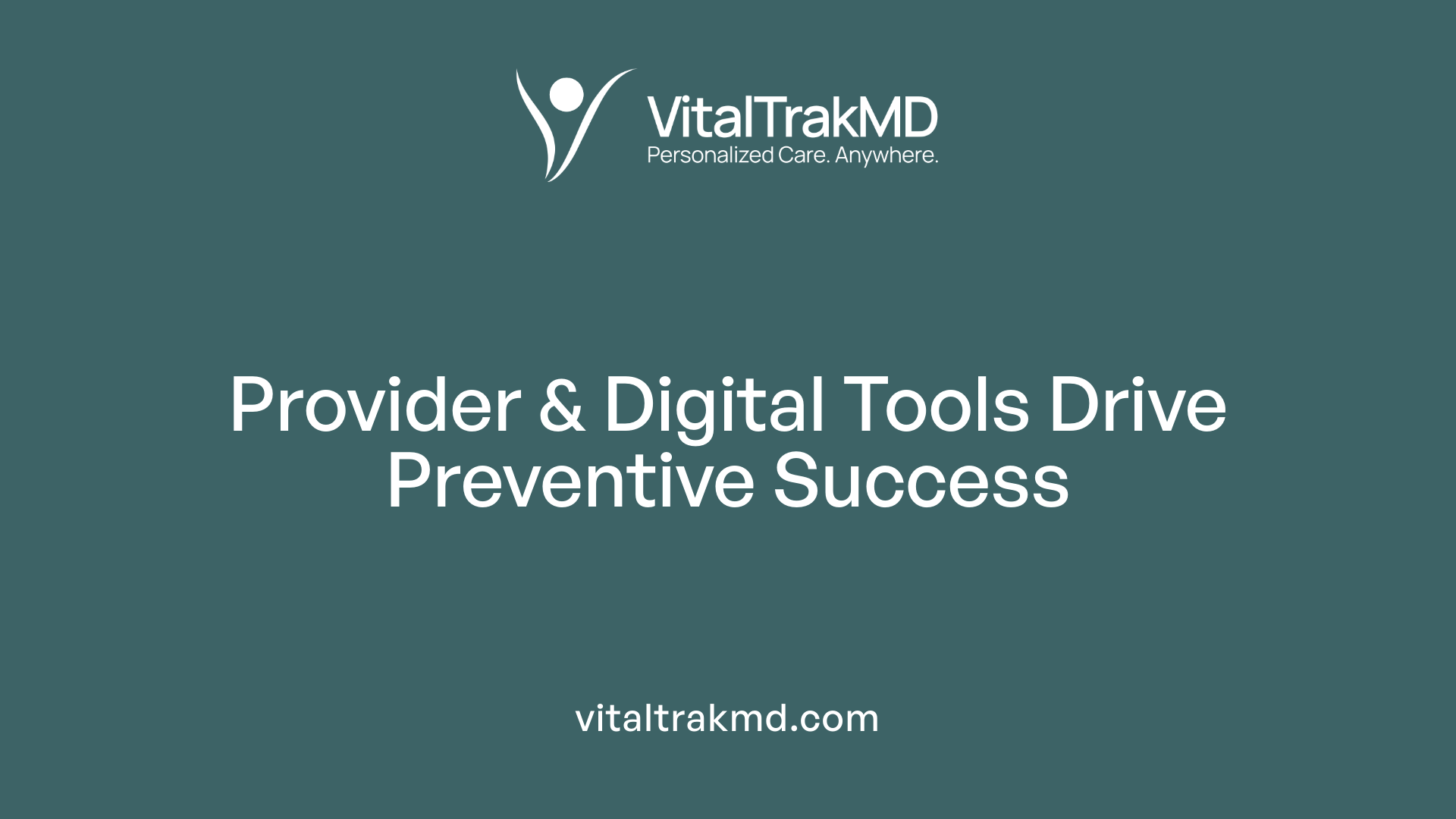
What strategies and health system approaches can enhance the success of hybrid preventive programs?
Implementing hybrid preventive programs effectively requires a combination of strategic planning, tailored interventions, and supportive health system changes. One approach is to adopt implementation science frameworks like RE-AIM (Reach, Effectiveness, Adoption, Implementation, Maintenance) or EPIS (Exploration, Preparation, Implementation, Sustainment). These frameworks provide structured methods to guide the integration of interventions over various stages, ensuring sustainable adoption.
Multicomponent strategies have proven particularly effective in increasing the delivery of preventive care. For instance, clinical reminders significantly boost process measures, making it easier for primary care providers to identify eligible patients and adhere to guidelines. Similarly, clinician education enhances knowledge and confidence, leading to better screening rates.
Facilitated relay of information, such as automated data sharing or alerts, can further improve provider responsiveness. These combined approaches can increase the likelihood of preventive measures being delivered consistently.
Using hybrid effectiveness-implementation study designs allows researchers and health systems to assess both clinical outcomes and implementation processes simultaneously. This dual focus helps identify barriers early, adapt interventions proactively, and accelerate translation into practice.
Organizational readiness—such as leadership support, staff training, and resource availability—is vital for success. Tailoring interventions to specific healthcare settings and patient populations enhances relevance and uptake.
Regular evaluation of implementation outcomes like acceptability, feasibility, and sustainability ensures that preventive programs remain effective and equitable. Metrics also include health equity assessments to prevent disparities.
Incorporating these strategies into routine healthcare delivery supports a culture of continuous improvement, ultimately leading to higher screening rates, better health outcomes, and more efficient use of resources.
| Strategy | Effect | Additional Details |
|---|---|---|
| Clinical reminders | Significantly increases care processes | Odds ratio of 3.46, with wide confidence intervals indicating strong evidence |
| Clinician education | Boosts care processes | Odds ratio of 1.89, emphasizing the importance of ongoing training |
| Facilitated information relay | Enhances care delivery | Odds ratio of 1.95, showing improved communication |
| Multicomponent interventions | Overall positive impact | Increases processes with an odds ratio of 3.10 |
| Organizational support | Ensures sustainability | Involves leadership engagement and resource allocation |
These strategies together create a robust environment for improving preventive health services, ensuring data-driven, tailored, and sustainable improvements across diverse healthcare settings.
Bridging In-Person and Digital Care to Decrease Missed Screenings
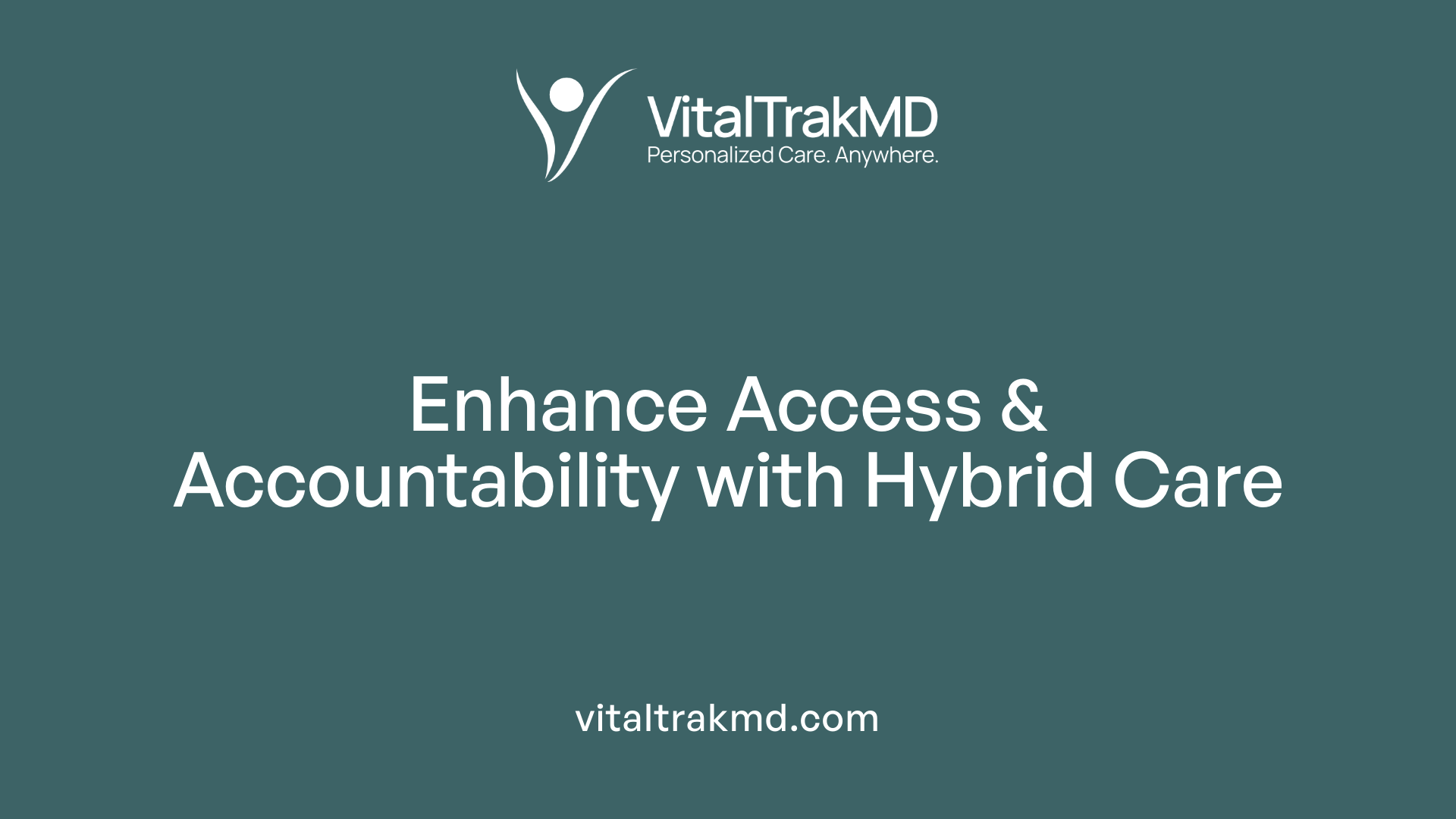
How do hybrid healthcare models help reduce the risk of missed preventive screenings?
Hybrid healthcare models are designed to combine traditional in-person visits with innovative digital tools, creating a more comprehensive approach to preventive care. These systems improve access for patients who might otherwise miss routine screenings due to barriers such as distance, transportation issues, or limited healthcare availability.
One major advantage of hybrid models is their ability to facilitate remote patient engagement. Telehealth consultations enable patients to connect with healthcare providers without traveling to clinics, making it easier to schedule and keep preventive appointments. Alongside virtual visits, digital tools like mobile apps and online portals allow patients to receive reminders about upcoming screenings and educational resources tailored to their health risks.
Digital alerts and clinical decision support systems embedded within these platforms actively prompt healthcare providers to recommend appropriate screenings based on individual patient profiles. This ongoing reminder system helps reduce oversight caused by busy clinical schedules or oversight, ensuring preventive measures are not overlooked.
Continuity of care is another critical benefit. With ongoing monitoring and follow-up enabled through digital channels, patients are more likely to stay engaged with their healthcare plans. These systems track screening schedules, notify patients of missed appointments, and facilitate rescheduling, which helps identify and address preventive health needs earlier.
Overall, hybrid healthcare models leverage multiple care delivery channels—combining in-person visits with digital interventions—to create a proactive, accessible, and patient-centered environment. This integrated approach not only increases the likelihood of screening adherence but also promotes better health outcomes by catching potential issues early and ensuring continuous patient engagement.
Evidence Supporting Effectiveness of Hybrid Programs in Preventive Screenings
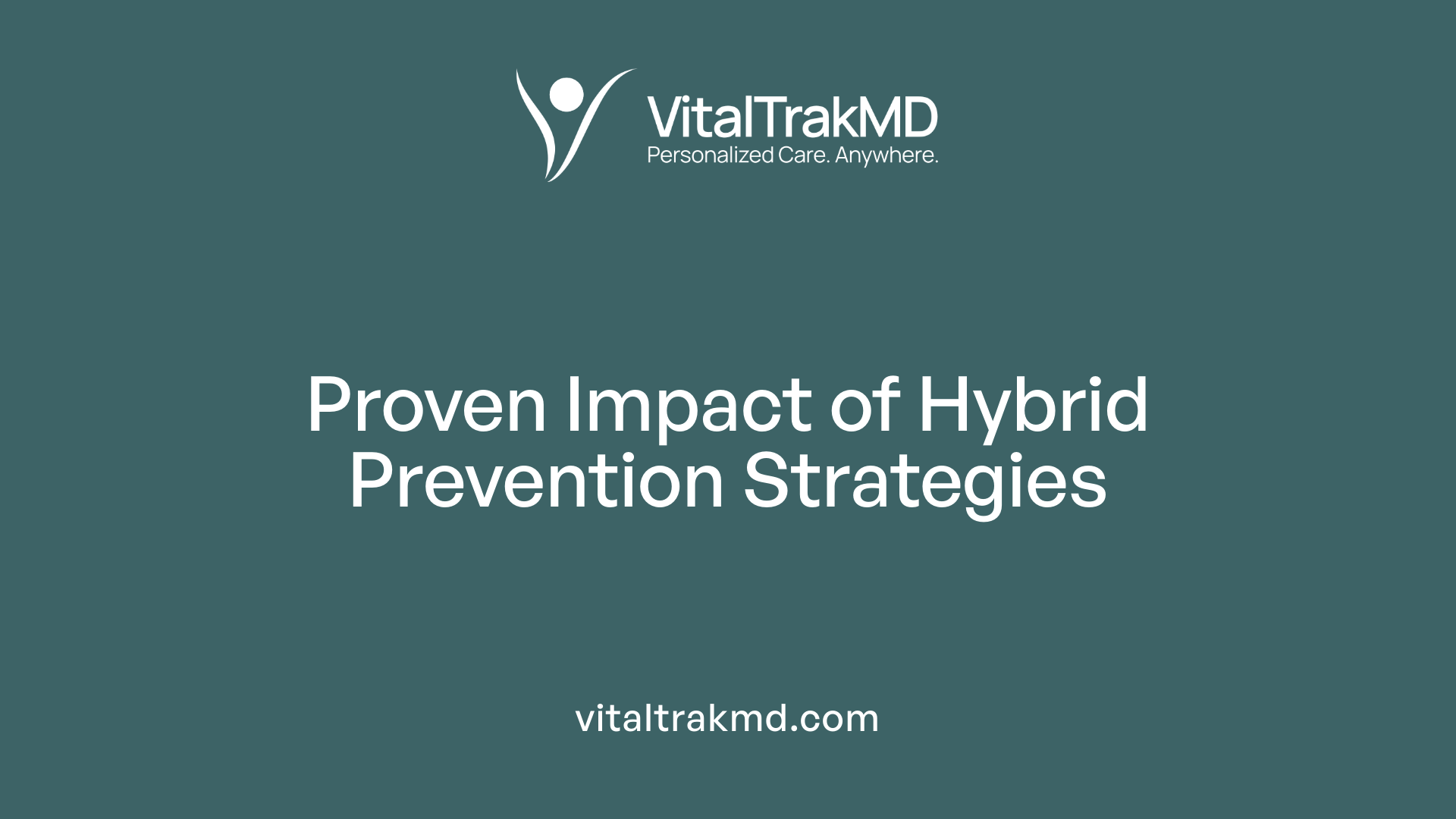
What is the evidence supporting the effectiveness of hybrid programs in preventing missed screenings?
Research studies indicate that hybrid programs are a promising approach for increasing preventive screening rates and reducing the number of missed screenings, especially among vulnerable populations. These programs typically combine in-person interventions with digital tools such as clinical reminders and telehealth, creating a multifaceted approach to care.
Hybrid models like the VA-DPP (Veterans Diabetes Prevention Program) have demonstrated higher fidelity and participant satisfaction compared to traditional or single-component programs. They successfully engage high-risk populations, showing not only increased participation but also more consistent adherence to intervention protocols.
Implementation frameworks such as RE-AIM (Reach, Effectiveness, Adoption, Implementation, Maintenance) and CFIR (Consolidated Framework for Implementation Research) facilitate understanding the multiple factors at play in deploying these interventions. These frameworks highlight the importance of organizational support, provider engagement, and patient-centered design in ensuring the sustainability of such programs.
One of the core strengths of hybrid programs is their ability to improve care processes significantly. For example, studies have reported that clinical reminders can increase preventive care activities with an odds ratio of 3.46, and clinician education can boost screening processes with an odds ratio of 1.89. Facilitated relay of health information and multicomponent strategies further enhance these outcomes, with odds ratios of 1.95 and 3.10, respectively.
In addition, these initiatives often lead to tangible improvements in patient health outcomes. The integration of systematic interventions, such as Best Practice Advisories (BPA) and nurse navigators, has been associated with increased screening rates and better alignment of the screened population's risk profiles.
Effective implementation relies on addressing barriers such as low referral rates, time constraints, and logistical challenges, while facilitators include strong leadership, trained staff, and supportive health policies. The costs associated with these programs are often comparable or even lower than universal community-based options, with estimates around $68 for eligibility assessment, $328 for maintaining adherence, and about $101 per session.
Overall, the evidence from diverse settings supports that hybrid preventive programs effectively increase screening uptake, decrease missed screenings, and improve overall program quality. The integrated use of digital technologies, clinician engagement, and community-based approaches creates an effective environment for preventive health, especially for high-risk groups who often face barriers to care.
The continuous development and evaluation of these programs, guided by robust implementation science, promise greater scalability and sustainability in reducing the burden of preventable diseases.
Addressing Barriers During Crises with Hybrid Models
How do hybrid healthcare models address barriers to preventive care during challenging circumstances like a pandemic?
Hybrid healthcare models serve as effective solutions to maintain preventive care during times of crisis such as the COVID-19 pandemic. These models combine virtual and in-person care options, creating a flexible system that adapts to external challenges.
By integrating telehealth, remote monitoring, and digital diagnostics, hybrid systems allow healthcare providers to engage with patients without requiring physical visits. This continuous engagement helps ensure ongoing management of chronic conditions, health education, and follow-up care, even when in-person appointments are limited or unsafe.
Telehealth platforms facilitate virtual consultations, enabling patients to receive medical advice, screenings, and preventive services from their homes. Remote monitoring devices can track vital signs and health metrics, providing real-time data to clinicians, which supports early detection and timely intervention.
These systems also support home hospitalizations and virtual clinics, reducing unnecessary hospital visits and conserving healthcare resources during overwhelmed periods.
Furthermore, hybrid models significantly improve access for rural and underserved populations. By removing barriers related to transportation, distance, and resource limitations, they ensure that vulnerable groups continue to receive essential preventive care.
During crises, such as pandemics, the flexibility of hybrid healthcare models enhances system resilience, allowing healthcare providers to adapt quickly to changing circumstances while maintaining high-quality, patient-centered care.
Benefits of hybrid models in ensuring preventive care during emergencies
| Aspect | Description | Impact |
|---|---|---|
| Continuity of Care | Combining virtual and in-person services | Maintains ongoing patient engagement and monitoring |
| Resource Conservation | Reduces hospital visits and resource use | Decreases burden on healthcare system |
| Increased Access | Overcomes transportation and geographic barriers | Reaches underserved and rural populations |
| Risk Reduction | Minimizes exposure to infectious agents | Protects vulnerable patients and staff |
| Flexibility and Adaptability | Rapidly adjust service delivery methods | Ensures service availability during disruptions |
Strategies to Implement Effective Hybrid Models
- Utilizing telehealth platforms for consultations and follow-ups
- Deploying remote patient monitoring devices for real-time health data collection
- Developing virtual clinics and mobile health applications
- Educating patients on telehealth use and digital tools
- Ensuring equitable access, including language and technology support
As hybrid healthcare continues to evolve, especially during emergencies, these models are vital for sustaining preventive health services, preventing missed screenings, and addressing social and logistical barriers affecting high-risk populations.
Cost-Effectiveness and Efficiency of Hybrid Programs
How much do hybrid programs cost to implement?
Hybrid preventive care programs often balance clinical effectiveness with economic feasibility. For example, the VA-DPP demonstrated that the costs per individual for assessing eligibility, scheduling, maintaining adherence, and delivering sessions were approximately $68, $328, and $101 respectively. When summed, these costs are comparable to or even lower than traditional community-based Diabetes Prevention Programs (DPP). Such cost structures support the scalability of hybrid models by providing a financially sustainable option for large populations.
How are resources utilized in hybrid interventions?
Resource allocation in hybrid programs is optimized through strategic use of personnel, technology, and infrastructure. Skilled staff such as nurse navigators, community health workers (CHWs), and clinicians work together to deliver multifaceted interventions, including behavioral counseling, medical assessments, and follow-ups. Technology plays a pivotal role; AI-driven predictive analytics and wireless sensor systems help in early detection, medication adherence monitoring, and risk stratification, reducing unnecessary in-person visits and making resource use more efficient.
What are the costs associated with delivering individual sessions?
The delivery of each session in hybrid models typically costs around $101. This encompasses labor costs, materials, and any technology-based support such as telehealth platforms. These costs tend to be lower than standalone behavioral programs, owing to streamlined processes and remote or low-resource delivery methods, which reduce time and infrastructure expenses.
How do hybrid programs compare to traditional or community-based programs?
Compared to traditional models, hybrid programs often achieve higher fidelity and participant satisfaction, as seen with the VA-DPP. They can deliver comparable or better health outcomes at similar or reduced costs. For example, hybrid models facilitate engagement through telehealth, community health workers, and digital analytics, thus reaching more high-risk individuals effectively. This reduces missed opportunities for prevention, further increasing overall efficiency.
| Aspect | Cost Estimate | Description | Impact on Program Efficiency |
|---|---|---|---|
| Eligibility assessment | $68 | Costs for initial screening | Ensures proper targeting, minimizes unnecessary testing |
| Scheduling & adherence | $328 | Maintaining engagement and compliance | Keeps participants in care longer, improves outcomes |
| Session delivery | $101 per session | Cost per clinical or behavioral session | Supports scalability with predictable expenses |
| Total per participant | Approx. $497 | Sum of above costs | Comparison point against community-based approaches |
What factors influence the cost-effectiveness of hybrid programs?
Factors such as leadership support, staff training, and integration with national health policies play significant roles. High fidelity in implementation ensures resources are used efficiently, maximizing health benefits relative to costs. The use of AI and wireless sensors not only enhances care but also reduces long-term expenses by preventing disease progression and avoiding costly late-stage treatments.
Are hybrid approaches a sustainable investment?
Hybrid models demonstrate promise as sustainable investments in preventive health. Their ability to deliver targeted interventions with lower costs per participant, combined with technological enhancements and community engagement, makes them a promising approach to large-scale health promotion. Ongoing evaluation and refinement can further improve resource utilization, ensuring these programs remain cost-effective over time.
The Role of AI and Predictive Analytics in Preventive Care
How does AI-driven risk assessment support preventive care?
AI-driven risk assessment uses advanced algorithms to analyze large datasets, helping clinicians identify individuals at higher risk for various diseases. This proactive approach allows healthcare providers to focus resources effectively, ensuring that those who need preventive interventions receive appropriate attention.
For example, predictive analytics can scrutinize electronic health records, lifestyle information, and genetic data to determine the likelihood of developing chronic conditions such as diabetes or COPD. These insights facilitate early intervention, potentially delaying or preventing disease progression.
What is predictive modeling, and how does it improve health outcomes?
Predictive modeling employs statistical techniques and machine learning to forecast future health events based on historical data. By analyzing patterns across diverse health variables, models can estimate the probability of disease occurrence or deterioration.
For instance, models might project the risk of lung cancer in current smokers based on age, smoking history, and occupational exposures. This allows for tailored screening programs and personalized health advice, ultimately leading to better health outcomes.
How do customized patient recommendations enhance preventive efforts?
Prescriptive analytics extend beyond prediction by offering specific, personalized guidelines that incorporate individual social, economic, and environmental factors. These customized recommendations aim to improve adherence and effectiveness of preventive strategies.
In practice, this means that a patient with limited access to healthy foods might receive guidance that considers local resources or community support services. Tailoring advice increases relevance and likelihood of follow-through, reducing barriers to preventive care.
In what ways does AI assist in early detection of diseases?
AI enhances early detection by analyzing diagnostic images, laboratory data, and other health indicators more accurately and rapidly than traditional methods. For example, AI models trained on imaging data can identify early signs of lung cancer at stages where intervention is most effective.
Wireless sensor systems powered by AI can monitor medication adherence, such as insulin use in diabetic patients, providing real-time data that supports ongoing management and early identification of issues. Overall, AI helps catch health issues sooner, enabling timely preventive actions.
| Aspect | Description | Additional Details |
|---|---|---|
| Risk assessment | Uses data analysis to identify high-risk individuals | Guides targeted screening and intervention |
| Predictive modeling | Forecasts disease risk based on historical data | Supports proactive health management |
| Customized recommendations | Personalizes advice incorporating social, economic, environmental factors | Increases adherence and relevance |
| Early detection | Uses AI tools to identify diseases at initial stages | Improves treatment efficacy and reduces late-stage diagnoses |
AI and predictive analytics are transforming preventive care by enabling early detection, personalized recommendations, and efficient allocation of resources. As these technologies develop and integrate further into healthcare systems, the potential to improve health outcomes and extend life expectancy becomes increasingly achievable.
Community Engagement and Lifestyle Interventions in Hybrid Models
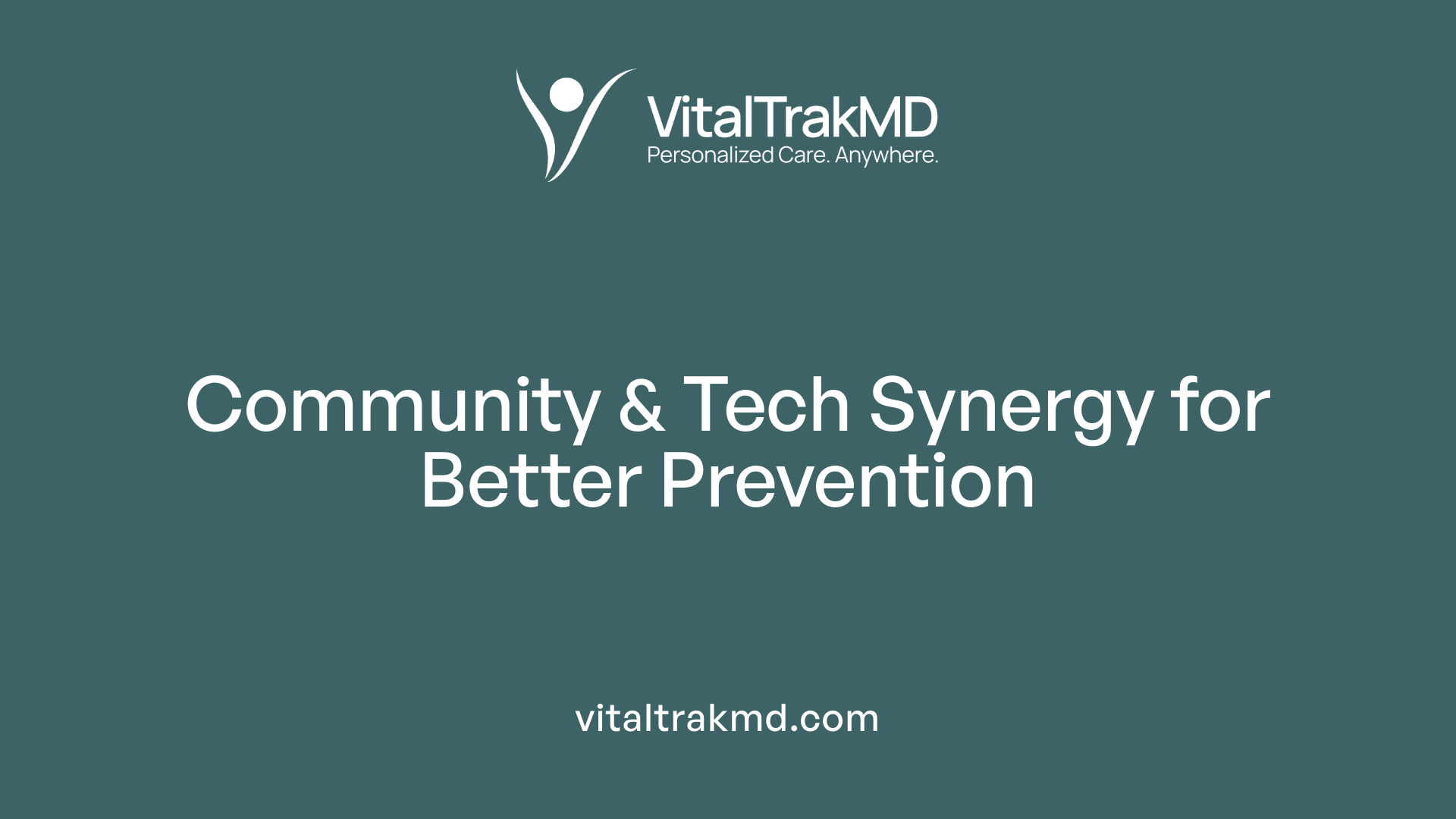
How do hybrid programs help reduce the risk of missed preventive screenings?
Hybrid models that integrate community engagement with technological tools have proven effective in decreasing the incidence of missed preventive screenings. These programs combine in-person interactions with telehealth, mobile apps, and remote monitoring to improve patient access and engagement.
In rural and underserved areas, digital health tools are crucial for maintaining continuous care. Patients receive reminders for upcoming screenings and educational content through their devices, which helps them stay informed and motivated to participate in preventive services.
Clinician decision support systems embedded within these platforms prompt healthcare providers to recommend necessary screenings during patient visits, reducing oversight. This is especially important given that provider behavior varies, and systematic interventions like Best Practice Advisories (BPAs) can significantly influence screening activity.
The seamless continuity provided by hybrid strategies supports ongoing follow-up. Patients are more likely to adhere to screening schedules when care is accessible, personalized, and reinforced through various channels.
Overall, hybrid programs foster a proactive healthcare environment. They lower barriers such as transportation, appointment availability, and healthcare provider engagement, enabling earlier detection and intervention. As a result, these models not only improve individual health outcomes but also enhance overall program quality and efficiency.
How do systematic interventions like BPAs and nurse navigators increase screening rates?
Implementing targeted interventions such as Best Practice Advisories (BPAs) and nurse navigators has shown positive impacts on screening rates within hybrid programs. BPAs serve as real-time prompts within electronic health records, reminding providers when patients meet criteria for screenings like lung cancer or cardiovascular risk assessments.
Nurse navigators complement this by providing personalized support, education, and guidance to patients. They help coordinate appointments, address fears or misconceptions, and ensure follow-up, which is vital for high-risk populations.
Studies reveal that BPAs can influence provider behavior significantly, boosting screening activity in primary care settings. Additionally, these systematic inputs help in reducing the screening of ineligible patients, maintaining focus on those truly at risk.
Effective system-level interventions augment provider efforts, streamline workflows, and foster better adherence to screening guidelines. Together, BPAs and nurse navigators contribute to a more efficient, patient-centered approach to preventive care.
What role do community health workers play in lifestyle improvement programs?
Community health workers (CHWs) are pivotal in delivering low-intensity, community-based lifestyle programs like the CHANGE initiative aimed at reducing cardiovascular disease risks among rural populations. In these programs, CHWs serve as trusted liaisons who understand local contexts and barriers.
Delivered over a four-month period, the intervention involved behavioral counseling on diet, physical activity, and blood pressure management. CHWs provided ongoing support through education, encouragement, and follow-up, which were crucial for patient engagement.
Participants in these programs experienced measurable health benefits. Key improvements included a mean reduction of 2.5 mmHg in systolic blood pressure and 2.1 mmHg in diastolic pressure. Additionally, more individuals reached blood pressure levels below clinical thresholds, with increases of 7 percentage points for systolic and 9 for diastolic.
Dietary habits improved, with increased servings of fruits, vegetables, and nuts. Physical activity increased by approximately 45 minutes per week on average. High retention (87%) and fidelity in delivering the intervention demonstrated feasibility and acceptability in rural settings.
CHWs also addressed social determinants of health, such as food insecurity and housing difficulties, which are often barriers to maintaining healthy behaviors. This community-clinical linkage approach supports comprehensive health improvements, helping close the gap in preventive care among high-risk groups.
How do retention rates and intervention fidelity influence program success?
Retention and fidelity are crucial indicators of the feasibility and potential sustainability of community health programs. The high retention rate of 87% observed in the CHANGE study indicates that most participants remained engaged throughout the intervention, which is essential for obtaining reliable outcomes.
Fidelity in intervention delivery, meaning how accurately the program is implemented as planned, ensures that participants receive the intended care and support. The good fidelity reported suggests that CHWs delivered the lifestyle program consistently, maintaining its integrity and effectiveness.
Together, high retention and fidelity highlight that low-intensity, community-based interventions are practical and acceptable for rural populations. These factors contribute to better health outcomes and support the scalability of such programs.
Broader implications for community-based health programs
Effective community engagement, systematic provider support, and lifestyle interventions form a robust framework for improving preventive health care. These strategies can be adapted to various health issues, including lung cancer screening, CVD risk reduction, and pediatric care.
Multicomponent interventions, that combine clinical reminders, community outreach, and behavioral support, significantly increase care processes. They help overcome barriers related to access, social determinants, and provider practices.
While these strategies show promising outcomes, it's important to acknowledge that behavioral change outcomes, such as smoking cessation, may require additional targeted approaches. Nonetheless, integrating community and technological resources creates a comprehensive system capable of advancing preventive health efforts across diverse populations.
| Program Element | Impact | Additional Notes |
|---|---|---|
| Digital health tools | Increased screening adherence | Reminders, telehealth, monitoring |
| Systematic alerts | Better provider compliance | BPAs, clinical prompts |
| Community health workers | Improved lifestyle behaviors | Personalized support, local insights |
| Fidelity & retention | Sustain program success | Consistent delivery enhances outcomes |
| Cost considerations | Program sustainability | Approximate $68-$328 per participant |
Future Directions and Scale-Up Strategies
How can implementation of hybrid lung cancer screening models and other preventive programs be scaled effectively?
Scaling up hybrid preventive health programs involves expanding proven strategies like systematic interventions, including Best Practice Advisories (BPAs) and nurse navigators, to broader populations and settings. These tools have shown to increase screening rates by steering provider behavior and improving program quality. For instance, BPAs help primary care providers (PCPs) identify eligible patients more consistently, reducing ineligible screenings and ensuring that individuals at higher risk receive timely interventions.
Effective expansion depends on integrating these systems within existing healthcare workflows. Careful planning is needed to tailor interventions such as automated alerts and patient navigation services, which are crucial for reaching underserved populations. The success of programs like VA-DPP highlights how high-fidelity, patient-centered approaches can be retained during scale-up, especially when supported by engaged leadership, well-trained staff, and aligned healthcare policies.
What sustainability measures can maintain health gains?
Sustainable implementation requires ongoing training, adaptable protocols, and continuous monitoring. The CHANGE study demonstrated that low-intensity community-based programs could achieve high retention (87%), indicating that simple, scalable models are feasible over time and in rural settings. Embedding interventions into standard care practices ensures their longevity.
Additionally, addressing social determinants of health—such as economic hardship, housing insecurity, and food insecurity—facilitates long-term health improvements. Incorporating social support services with preventive care plans helps sustain positive behaviors and health outcomes.
How important is health policy support?
Strong policy backing is vital for scaling preventive interventions. Policies that promote reimbursement for preventive services, incentivize primary care engagement, and facilitate telehealth adoption create an enabling environment. For example, national healthcare policies that support community-clinical linkages have been shown to enhance intervention reach and effectiveness.
Furthermore, policy efforts emphasizing the integration of AI-driven analytics for early detection and tailored interventions can optimize resource use and improve outcomes.
What strategies can help in scaling effective approaches?
Scaling effective strategies involves multifaceted approaches:
| Strategy | Description | Benefits |
|---|---|---|
| Clinical reminders | Use of automated alerts to prompt PCPs during patient encounters | Significantly increases screening and preventive care processes |
| Provider education | Training clinicians on guidelines and benefits of preventive measures | Improves care delivery and adherence |
| Facilitated information relay | Secure channels for real-time data sharing | Ensures timely interventions |
| Multicomponent interventions | Combining reminders, education, and patient engagement | Maximizes uptake of preventive services |
These strategies have demonstrated success in increasing care processes but show limited evidence for behavioral changes like smoking cessation or weight loss. Nonetheless, combining multiple approaches—particularly those that include systemic tools and community engagement—offers the best pathway to widespread adoption.
What are the challenges and opportunities in scaling these programs?
Barriers such as low referral rates, limited clinician time, and resource constraints need addressing. Opportunities include leveraging AI for personalized risk assessment, expanding telehealth services, and co-locating services to improve access.
Continued research and policy initiatives are needed to refine these models, ensuring they are adaptable to various healthcare settings, especially underserved regions. Emphasizing community engagement, technological integration, and supportive policies will drive the broader implementation of effective hybrid preventive care models and sustain their benefits over time.
Summary and Final Insights
Key Takeaways
Implementing hybrid lung cancer screening models is an effective way to enhance screening rates. Systematic interventions such as Best Practice Advisories (BPAs) and nurse navigators play a pivotal role in this process. These tools not only increase the likelihood of eligible patients being screened but also improve the overall quality of screening programs by focusing on high-risk populations and adhering to guidelines.
Provider behavior varies across different settings, but systematic tools like BPAs have shown promise in influencing primary care providers (PCPs) to increase screening activity. This approach can be extended to other preventive health interventions, including programs like VA-DPP, which deliver tailored weight loss and lifestyle improvements for high-risk groups.
The broader implementation of multicomponent interventions is associated with significant improvements in preventive care processes. Clinical reminders, staff training, and facilitated communication are notable facilitators that can boost adherence to preventive protocols, although behavioral outcomes like smoking cessation may require additional strategies.
In rural and underserved communities, community health workers (CHWs) effectively deliver low-intensity lifestyle programs. The CHANGE study exemplifies this, demonstrating reductions in blood pressure and improvements in diet and physical activity, while maintaining high retention and fidelity.
The COVID-19 pandemic severely impacted preventive pediatric visits, with over a quarter of visits delayed or missed, especially among vulnerable populations facing social hardships. Addressing social determinants and leveraging alternative delivery methods such as telehealth are critical to closing these gaps.
Furthermore, AI-driven predictive and prescriptive analytics are transforming preventive care by enabling early detection, personalized recommendations, and medication adherence monitoring. These technologies demonstrate potential to extend life expectancy and improve quality of life for patients with chronic conditions.
Impact on Health Equity
Systematic interventions in screening programs, like BPAs and nurse navigators, can reduce disparities by increasing access among underserved populations, ensuring high-risk groups receive appropriate prevention services.
Community-driven programs and AI technologies have the potential to bridge gaps in healthcare access, especially in rural or economically challenged settings. For instance, CHWs serve as vital connectors for high-risk populations, and AI systems can tailor interventions to individual social and environmental contexts.
The pandemic highlighted the importance of addressing social determinants of health, as households experiencing hardship are more likely to miss preventive visits. Strategies that incorporate social support, flexible delivery options, and community engagement are vital for equitable health outcomes.
Future Prospects
Looking ahead, integrating AI tools into preventive care offers promising prospects. As predictive models become more sophisticated, clinicians will be empowered to make earlier, more accurate decisions.
Expanding multicomponent interventions that combine clinical reminders, education, and community engagement can further boost preventive care processes.
Policymakers and healthcare systems should prioritize leadership support and resource allocation to overcome persisting barriers like clinician time constraints and logistical issues.
Moreover, innovative delivery methods, including telehealth and community partnerships, will be essential to sustain gains made during the pandemic and to reach vulnerable populations.
Continued research into the cost-effectiveness and impact of these interventions will guide best practices and foster the development of scalable, equitable prevention strategies that improve health outcomes for all communities.
Harnessing Hybrid Approaches for Cleaner Preventive Care
The integration of traditional and digital healthcare strategies through hybrid programs offers a promising path toward reducing missed preventive screenings. Evidence consistently demonstrates the effectiveness of multicomponent interventions—including clinical reminders, community engagement, and AI-driven analytics—in boosting screening uptake and adherence. These models not only address barriers posed by circumstances like the COVID-19 pandemic but also foster equitable access to preventive services, especially in rural and underserved populations. Future efforts should focus on refining implementation strategies, leveraging policy support, and expanding successful initiatives to ensure sustainable, scalable, and equitable preventive care for all.
References
- Impact of a Hybrid Lung Cancer Screening Model on ...
- A Hybrid Implementation-Effectiveness Study ...
- Missed and Delayed Preventive Health Care Visits Among ...
- Implementation findings from a hybrid III implementation ...
- AI and Preventive Care: What you need to know
- Strategies to improve the implementation of preventive care in ...
- Practical application of hybrid effectiveness ...
Recent articles
Want to Feel Better and Live Healthier?
Join hundreds of patients taking control of their health with personalized care that fits their life – not the other way around.
Rated 4.8/5 by 32+ customers







